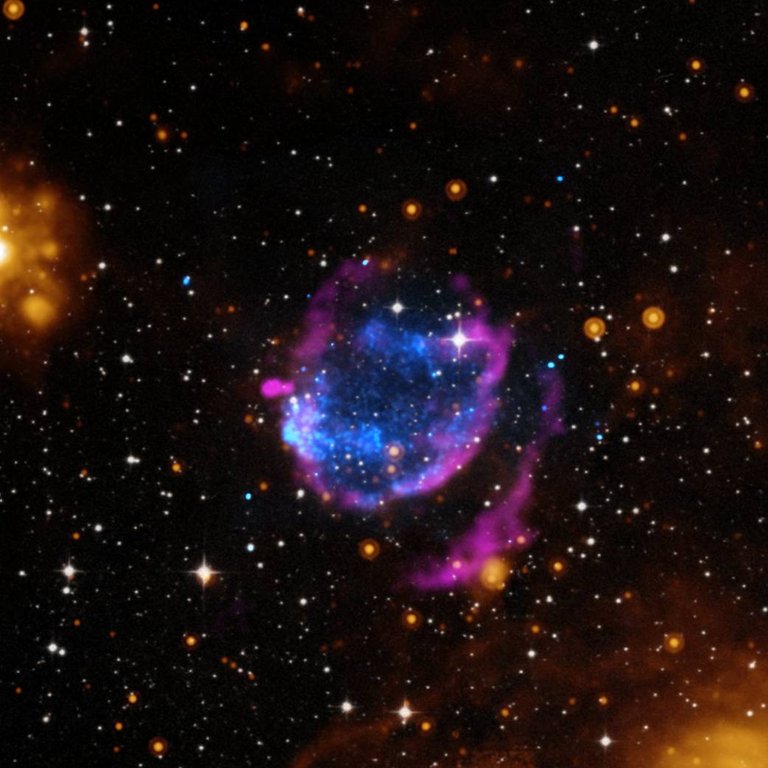
Image credit: ESA/Hubble & NASA (Source: NASA)
A supernova is the blast of a star. It's the largest blast that happens in the space.
Where can we find supernova formation?
Supernovas are oft determined in several galaxies. In any case, supernovas are onerous to seek out in our own Milky Way galaxy since dust impedes our read. In 1604, Johannes Kepler found the last watched star within the Milky Way Galaxy. NASA's Chandra telescope found the remaining parts of a later supernova. It detonated within the Milky Way Galaxy in more than 100 years back.

Image credit: NASA/CXC/SAO (Source: NASA)
The reason behind Supernova Formation
A supernova happens any place there's partner change inside the middle, or center, of a star. A modification will happen in 2 distinct manners, with each transfer a couple of stars.
The main quite star happens in star frameworks. Parallel stars are two stars that orbit an identical purpose. One in every one of the celebs, a carbon-oxygen white dwarf, takes matter from its friend star. Within the long-standing time, the white midget collects more than problems. Having more than the problem makes the star detonate, transportation a few supernovae.
Another sort of supernova occurs close to the completion of a lone star's lifetime. Since the star runs out of nuclear fuel, a tad bit of its mass streams into its middle. Finally, the core is hefty to the point that it can't resist its own gravitational power. The middle breakdown, that brings regarding the goliath blast of a star. The sun may be a solitary star, but it wants additional mass to show into a star.

Image credit: X-ray: NASA/CXC/NCSU/K. Borkowski et al (Source: NASA)
What's the need to Study Supernova?
A supernova consumes for simply a short timeframe, however, it will enlighten researchers a good deal regarding the universe.
One form of the supernova has incontestable researchers that we tend to board associate degree extending universe, one that's developing at an associate degree ever-expanding rate.
Researchers likewise have confirmed that supernovas assume a key half in dispersing parts during the universe. At the purpose, once the star detonates, it shoots parts and jetsam into space. A substantial ton of the parts we discover here on Earth is created within the center of stars. These parts head out on to form new stars, planets, and everything else renowned to the universe.

Image credit: X-ray: NASA/CXC/Morehead State Univ/T.Pannuti et al. (Source: NASA)
How do Scientists locate Supernova?
NASA analysts use fluctuated assortments of telescopes to search for and study supernovas. a couple of telescopes are used to observe the noticeable visible light from the blast. Other data from the X-rays and gamma rays are likewise created. Both NASA's Hubble Space Telescope and Chandra X-ray Observatory have captured an image of supernovas.
In June 2012, an independent agency sent the primary orbiting telescope that focuses light within the high-energy venue of the electromagnetic force vary. The NuSTAR mission has varied positions to try to to. It'll explore for collapsed stars and dark holes. It likewise can rummage around for the remaining elements of supernovas. Researchers arrange to study however stars detonate and therefore the elements that are created by supernovas.
References:
- https://www.nasa.gov/audience/forstudents/5-8/features/nasa-knows/what-is-a-supernova.html
- https://www.space.com/6638-supernova.html
- https://spacecenter.org/what-is-a-supernova/
- https://spaceplace.nasa.gov/supernova/en/
Congratulations @science-popper! You have completed the following achievement on the Hive blockchain and have been rewarded with new badge(s) :
You can view your badges on your board and compare yourself to others in the Ranking
If you no longer want to receive notifications, reply to this comment with the word
STOP@engrave
You guys @crazy-science and @science-popper should cooperate on a single blog. That would be cool!
Thanks a lot, @engrave for your unconditional support from the very first day.
I don't have any words to thank you for your delegation as well because of which I am able to engage freely. Also, thanks a lot for visiting @science-popper profile on my request. She is totally new to the blockchain technology and presently in learning and understanding mode. She has a very good potential of becoming a successful blogger. When I realized that I have called her on #Hive. Introduced her to hive and presently trying to make her familiar with everything here. Maybe in the near future, we can work on some joint blogs. But her interest areas are different except space science. We both only share one common area of interest and that is space science. Except that she is an IT professional and me an Electronics and Communication professional. :)
As a token of thanks, we both have voted for your witness. Thanks a lot once again and we love your work that you are doing for the community. :)